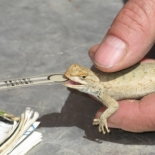Quantify Lizard Bite Forces with Flexible Sensors
Background: For the past seven years, a Montana family has gone to Desolation Canyon, Utah, for a white water rafting and camping trip. As years have gone by, they have noticed the large number of lizards living in the area and always wondered how they differed with respect to bite force. They decided this would be a perfect experiment to conduct as a science fair project for one of their children.
Challenge: How to safely, accurately, and cost effectively measure the bite force of lizards.
Solution: The thinness and low-cost of the FlexiForce™ force sensors made it the ideal solution for their project. Using a "catchpole," consisting of a fishing pole fitted with a soft cloth and loop, made for an easy way to capture the lizards. The soft cloth prevented injury to the lizards and the catchpole allowed the children to stay out of the lizard's line of vision, which in turn made for an easier and less traumatic experience for the lizards. The lizards were then weighed, measured, and placed in a bucket for testing. To improve the repeatability of their testing, the thin FlexiForce sensors were glued to a popsicle stick, allowing the lizards to bite an actual object*.
Over 30 animals were tested successfully over the two week expedition. It was found that the Western Fence lizard bites twice as hard and more often (100 percent of the time) than other lizards. Most lizards were aggressive and bit right away, while others needed coaxing. The first subject was a 6 inch Western Fence ("Bluebelly"), which struck hard and convincingly, registering a 273 KOhm reading. The second strike was a lower force, registering a reading of 313 KOhm. The Western Whiptail lizards only bit the sensor fifty percent of the time, suggesting it is less aggressive. It took a 12 inch Whiptail to produce the bite equivalent to a 6 inch Western Fence lizard.
* No animals were harmed during these experiments.
Benefits of FlexiForce™ Sensors
- Ultra-thin sensor construction and flexibility means minimal interference/disturbance to normal action
- Accurate response gives your customers and end users confidence in the performance of your product
- Knowledgeable, experienced technical staff help you develop the most effective, economical sensor based on your specific requirements. All manufacturing takes place at ISO 9001 compliant & 13485 registered Tekscan headquarters.
- 100% factory inspection ensures your sensors meet established performance specifications
Getting Started with FlexiForce Sensors
FlexiForce sensors are available off-the-shelf in packs of four or eight for testing and prototyping. Visit our online store to place an order, or contact us to discuss customization options with one of our engineers.
How about Human Bite Force?
Tekscan is the leader in dental bite force measurement with our T-Scan product.
